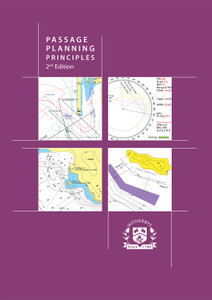
This publication analyses the four stages of passage planning – appraisal, planning, execution and monitoring. It works through an example of a passage from Rotterdam to Gibraltar, highlighting the key tasks that form the basis of an effective plan. This book should be read alongside its companion title, ‘Passage Planning Principles’.
This book guides the reader through preparation of a passage plan, providing detailed information at each step to ensure that nothing is overlooked.
It gradually builds a complete passage plan for a voyage from Rotterdam to Gibraltar, providing chart extracts for each leg of the passage, template plans and checklists.
This publication will be of great benefit to those who are new to passage planning, or as a reference guide for more experienced crew.
All ships should prepare a passage plan that covers the voyage from the departure berth to the arrival berth. It should adhere to national and international regulations as well as any Company Standing Orders. Where appropriate, it must also follow navigational advice and standards within the Company’s Safety Management System.
Ships of a particular Company are likely to adopt a similar format for their passage plans, although variations caused by cargo type, ship type or draught or commercial agreements are possible.
The passage plan described here has not been prepared to any specific Company instructions.
The main difference between passage plans is in the layout. In general, Company specific documents, such as pro-formas and checklists, are used. For this plan, we have provided a generic layout, which balances the information on the chart with other related passage plan documents. Remember to use all relevant passage plan documents in conjunction with the navigational charts.
This book is designed to be read alongside the first chapter of, 'Passage Planning Principles', (ISBN 978-1-85609-853-3), where many of the terms and concepts are described in more detail.
1. Voyage Instructions
2. Confirmation of Destination
2.1 Task 1: Confirm Destination
2.2 Task 2: Establish Route
2.3 Task 3: Calculate Distances
3. Appraisal
3.1 Task 4: Collate Company, Master and Charterer’s Instructions
3.2 Task 5: Gather General Information
3.3 Task 6: Collect and Note Cargo Information
4. Planning
4.1 Procedure for Chart Selection
4.2 Task 7: If the largest-scale charts for the voyage (or part of the voyage) are not on board, they must be requisitioned
4.3 Task 8: Identify predicted areas of danger and mark on charts
4.4 Task 9: Lay-off the courses, clear of hazards and dangers
4.5 Calculation of Wheel Over Point
4.6 Steps to Draw Wheel-Over Bearing by Advance Transfer Method
4.7 Use of Large Scale Plans within Small Scale Charts
4.8 Task 10: Mark all identified hazards
4.9 Use of the ‘Admiralty List of Lights’
4.10 Use of Admiralty List of Radio Signals
4.11 Calculation of Radar Horizon
4.12 Transferring Position from one Chart to another Chart
4.13 Use of Admiralty List of Radio Signals for Information about RACONS
4.14 Use of Admiralty List of Radio Signals for information on DGPS Beacons
4.15 Task 11: Identify the hazards
5. Execution
5.1 Task 12: Allocate Resources for Bridge Team Management
6. Monitoring
6.1 Task 13: Continuously monitor progress along the planned track
6.2 Anchor Plan
6.3 Berthing Plan
Appendices
Appendix 1: Own Passage Checklist
Appendix 2: Passage Plan, Bab-el-Mandeb to Jeddah Pilot Station
Appendix 3: Passage Plan, Jeddah Pilot Station to Berth
Appendix 4: Passage Planning Notebook
Appendix 5: Port Entry Information – Jeddah
Appendix 6: Ship’s Particulars and Manoeuvring Characteristics
Appendix 7: Chartwork Legends
Dr Captain Nadeem Anwar
Master Mariner, FNI, SFHEA, ACII, DoS, PGCEL, MSc (Maritime Operations), BSc (Quality Management), CertEd
Having completed pre-sea training in 1983, Capt Anwar sailed on a variety of ship types, including VLCCs, OBOs, O/Os, gas and chemical tankers. His time at sea was mainly spent in deep-sea trade, which gave him a wide-ranging experience of navigating in different areas of the world. He left sea while in command in 1998.
In education since 1998, he is now Senior Lecturer in the Petrochemical section at Warsash Academy and Leader for MSc - Shipping Operations (online).
Abdul Khalique
Master Mariner, MICS, PG Cert (Shipping), MSc (CBIS), HND Nautical Science, BSc (Maritime Studies)
After spending some time at sea, Abdul pursued a shore-based career. He was a Principal Lecturer in Maritime and Offshore Safety at Warsash Maritime Academy, a role that led him to the position of Head of the LJMU Maritime Centre at Liverpool John Moores University.
- Number of Pages:
- 49
- ISBN:
- 9781856098519
- Published Date:
- December 2019
- Binding Format:
- Paperback
- Book Height:
- 300 mm
- Book Width:
- 210 mm
- Weight:
- 0.6 kg
- Author:
Nadeem Anwar, Abdul Khalique
- Preview:
- Yes
- Publication Date:
- December 2019



